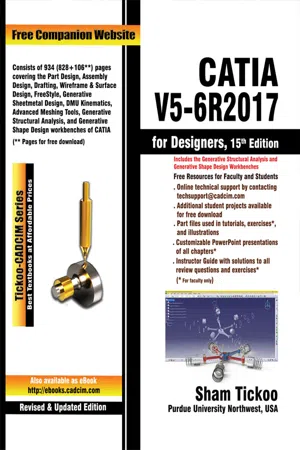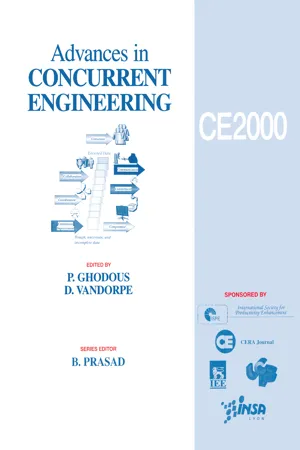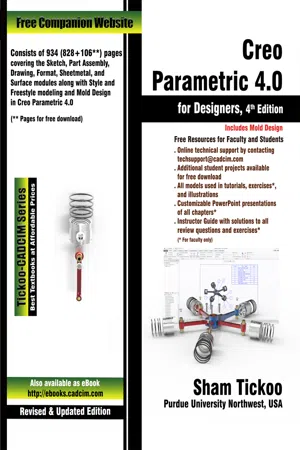Technology & Engineering
Assembly Modeling
Assembly modeling is a process of creating a virtual representation of a product or machine by combining individual parts and components. It allows engineers to visualize and analyze the interactions between different parts, ensuring that they fit together correctly and function as intended. Assembly modeling is commonly used in the design and manufacturing of complex products such as automobiles, aircraft, and machinery.
Written by Perlego with AI-assistance
Related key terms
Related key terms
1 of 4
Related key terms
1 of 3
5 Key excerpts on "Assembly Modeling"
- eBook - ePub
- Prof. Sham Tickoo(Author)
- 2021(Publication Date)
- CADCIM Technologies(Publisher)
Chapter 12Assembly ModelingL earning O bjectivesAfter completing this chapter, you will be able to: • Create bottom-up assemblies • Insert components into a Product file • Move and rotate components inside an assembly • Add constraints to individual components • Create top-down assemblies • Edit assembly designs • Create exploded state of assembliesAssembly ModelingAssembly Modeling is the process of creating designs with two or more components assembled together at their respective work positions. The components are brought together and assembled in the Assembly Design workbench by applying suitable parametric assembly constraints to them. The assembly constraints allow you to restrict the degrees of freedom of the components at their respective work positions . The assembly files in CATIA V5 are called product files. There are two methods to invoke the Assembly Design workbench of CATIA V5. The primary method to start a new product file is by choosing Start > Mechanical Design > Assembly Design from the menubar. The other method of invoking the Assembly Design workbench is by choosing File > New from the menubar. On doing so, the New dialog box will be displayed. In this dialog box, select Product , as shown in Figure 12-1.Figure 12-1 The Product option selected from the New dialog boxOn invoking the Assembly Design workbench, a new file is started. The screen display of CATIA V5 after starting the new file in the Assembly Design workbench is shown in Figure 12-2. You will also notice that the toolbars related to the assembly will be displayed. The tools in these toolbars will be discussed later in this chapter.Types of Assembly Design ApproachesFigure 12-2 Screen display after starting a new file in the Assembly Design workbenchIn CATIA V5, you can create assembly models by adopting two types of design approaches. The first design approach is the bottom-up approach and the second is the top-down - eBook - ePub
- Prof. Sham Tickoo(Author)
- 2018(Publication Date)
- CADCIM Technologies(Publisher)
Chapter 12�Assembly ModelingL earning O bjectivesAfter completing this chapter, you will be able to: • Create bottom-up assemblies • Insert components into a Product file • Move and rotate components inside an assembly • Add constraints to individual components • Create top-down assemblies • Edit assembly designs • Create the exploded state of assembliesAssembly Modeling
Assembly Modeling is the process of creating designs with twoor more components assembled together at their respective work positions. The components are brought together and assembled in the Assembly Design workbench by applying suitable parametric assembly constraints to them. The assembly constraints allow you to restrict the degrees of freedom of the components at their respective work positions . The assembly files in CATIA V5 are called product files. There are two methods to invoke the Assembly Design workbench of CATIA V5. The primary method to start a new product file is by choosing Start > Mechanical Design > Assembly Design from the menubar. The other method of invoking the Assembly Design workbench is by choosing File > New from the menubar. On doing so, the New dialog box will be displayed. In this dialog box, select Product , as shown in Figure 12-1.Figure 12-1 The Product option selected from the New dialog boxOn invoking the Assembly Design workbench, a new file is started in it. The screen display of CATIA V5 after starting the new file in the Assembly Design workbench is shown in Figure 12-2 . You will also notice that the toolbars related to the assembly will be displayed . The tools in these toolbars will be discussed later in this chapter .Figure 12-2 Screen display after starting a new file in the Assembly Design workbenchTypes of Assembly Design Approaches
In CATIA V5, you can create assembly models by adopting two type of design approaches. The first design approach is the bottom-up approach and the second is the top-down - eBook - ePub
The CAD Guidebook
A Basic Manual for Understanding and Improving Computer-Aided Design
- Stephen J. Schoonmaker, Lynn Faulkner(Authors)
- 2002(Publication Date)
- CRC Press(Publisher)
Chapter 10: Assembly Modeling
10.1 INTRODUCTION
Assemblies are simply groups of parts that are assembled or brought together in some fashion. They may be welded together (such as flat plates joined into a beam), or they may be fastened together (such as bolts holding a wheel to an axle), or they may just be parts that form a working unit (such as a barrel and rod in a hydraulic cylinder). Assembly models, then, are simply a 3-D CAD–based representation of these groups of parts. Figure 10.1 shows a example of an assembly model.10.2 CHARACTERISTICS OF AN ASSEMBLY MODEL
There are a number of essential characteristics of assembly models contained in a 3-D CAD system. If these elements are not present, then one needs to question whether the system is really doing Assembly Modeling at all. It may just be allowing many 3-D part models to be shown simultaneously, but with no real intelligence about the grouping of parts to the extent that it could be considered a real assembly 3-D model. The remainder of this section presents three essential char-acteristics for the assembly model—assembly structure, positional information, and instancing.FIGURE 10.1 An example of a simplistic assembly model.Naturally, assembly models are going to be dependent on 3-D modeling methods. Although a 2-D assembly model would be theoretically possible in a 2- D CAD system, assembly models are really only found in the context of 3-D CAD systems. Realistic assembly design is simply a very three-dimensional activity.10.2.1 Assembly Structure
The first essential characteristic of the assembly model is that it must have a structure. This is really just a list or perhaps a table (to use a database term). This list or table simply indicates the collection of 3-D part models (or details) within the assembly model. The assembly structure indicates what is actually in the assembly model. Figure 10.2 - eBook - ePub
Advances in Concurrent Engineering
CE00 Proceedings
- Biren Prasad(Author)
- 2023(Publication Date)
- CRC Press(Publisher)
Virtual Assembly for Concurrent Engineering presents a tool in hands of designer for correct and efficient design modeling. Most of the inadequacies of design assignment are discovered late, at the production or assembly stage. A virtual computer model to be used by the designer to deal with manufacturing and assembly problems at the design stage is needed. We will show the capability of the virtual technology to assist designer and help him with knowledge that are not relevant to his work, experience. The proposed virtual model leads designer trough assembly processes for the purpose of assembly planning and assemblability, to achieve one successful design that doesn’t need to be redesign, changed or rearranged. Virtual manufacture and assembly idea is to synthesize relevant requirement of design, manufacturing and assembly. Shifting of manufacturing and assembly requirements to the design stage will have remarkable impact on the design/production development cycle from conceptual stage to realization and verification.Value of the propose system for virtual manufacturing and assembly:The system being developed has several important differences from usually developed VR based simulation. It is implemented based on the real assembly practice, it achieves high speed frame rate on ordinary personal computer. Other very important issue is the user interface with VR environmental in the natural manner. No special knowledge or computer skills are required as the work within the immerse space VR assembly environmental with gloves, HMD and tracking sensors offer an easy non interrupting style of work.A virtual assembly/disassembly simulation for the Japanese manufacturing company was developed and tested. The goal of the project was developing of the VR assembly process simulation so designers can test their concept and if it proves correct to use it later for training of the personal. The factory settings have all parts, machines and tools placed in their corresponding place and user can manipulate them in ordinary way. The software and peripheries provides immerse feeling, 3 dimensional interface and workspace that ensures undisruptive usage of all elements taking part in the simulation.Figure 1. From interactive PC work to immerse environment2. Concurrent Engineering
Engineering is a cooperative process in which work is coordinated over an extended period of time. In the course of development effort, individual aspects of the product may be worked on concurrently by several engineers or teams. The situation is called Concurrent engineering (CE). There are three types of cooperative work in which data needs to be shared: work group of engineers, across the product life cycle and between enterprises involved in the joint development. [1 - eBook - ePub
- Prof. Sham Tickoo(Author)
- 2017(Publication Date)
- CADCIM Technologies(Publisher)
Chapter 10Assembly Modeling Learning Objectives After completing this chapter, you will be able to: • Understand the top-down assembly approach • Understand the bottom-up assembly approach • Assemble components of the assembly using assembly constraints • Understand the packaging of components • Create the simplified representations • Use the View Manager • Edit assembly constraints after assembling • Modify the components of an assembly • Create the exploded state of an assembly • Add offset lines to exploded components • Understand the Bill of Material in the assembliesAssembly ModelingAn assembly is defined as a design consisting of two or more components bonded together at their respective working positions using the assembly constraints. These assembly designs are created in the Assembly mode of Creo Parametric. To invoke the Assembly mode, choose the New button from the Quick Access toolbar; the New dialog box will be displayed. In this dialog box, select the Assembly radio button from the Type area and then select the Design radio button from the Sub-type area, as shown in Figure 10-1. Specify the name of the assembly in the Name edit box and choose the OK button; the Assembly mode will be activated. Also, the initial screen appearance of the Assembly mode in Creo Parametric will be displayed, as shown in Figure 10-2.Important terms related to the Assembly mode Before proceeding further in this chapter, it is very important for you to understand the following terms. Top-down ApproachThis is the method of assembling the components in which the components of the assembly are created in the same assembly file. In this type of Assembly Modeling approach, the components are created in the assembly file and then assembled using the assembly constraints. Note that the parts you create in the Assembly mode are saved as separate .prt
Index pages curate the most relevant extracts from our library of academic textbooks. They’ve been created using an in-house natural language model (NLM), each adding context and meaning to key research topics.
Explore more topic indexes
Explore more topic indexes
1 of 6
Explore more topic indexes
1 of 4




